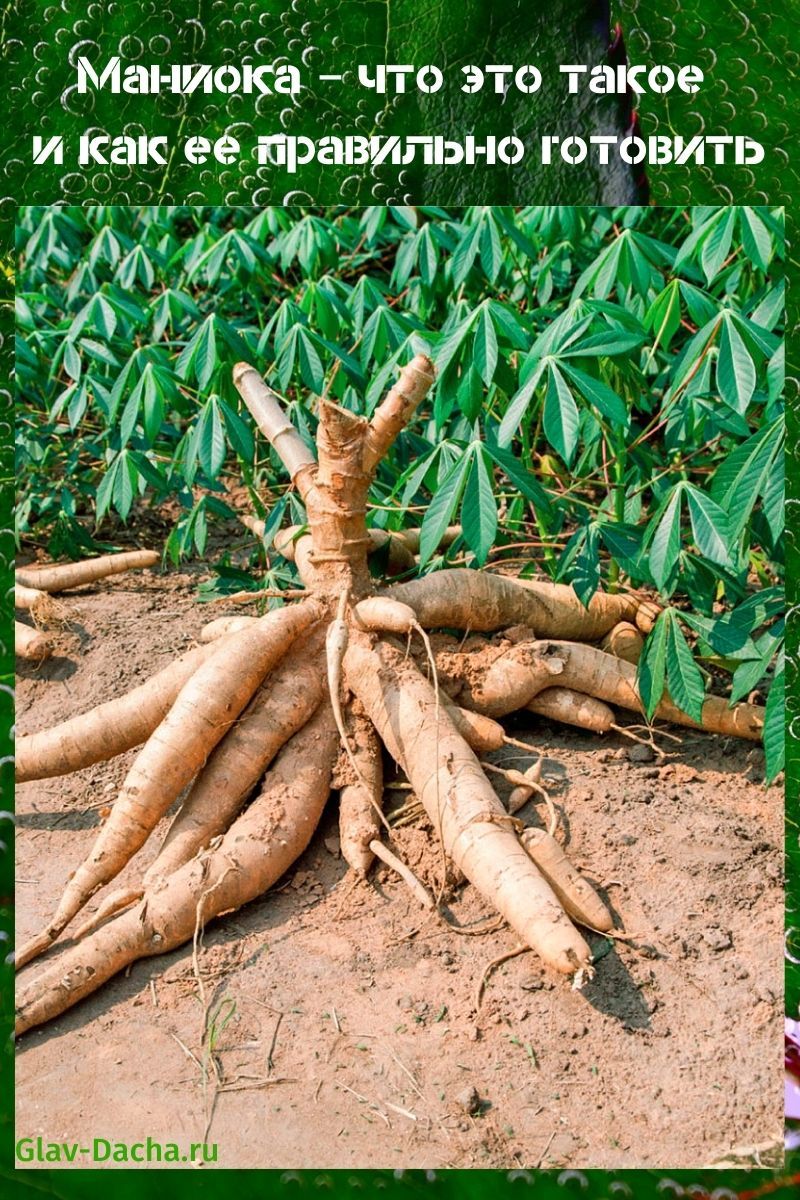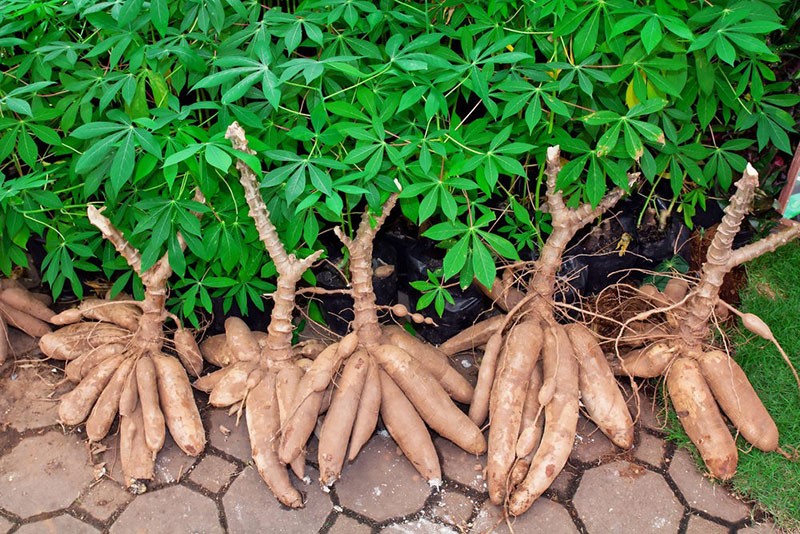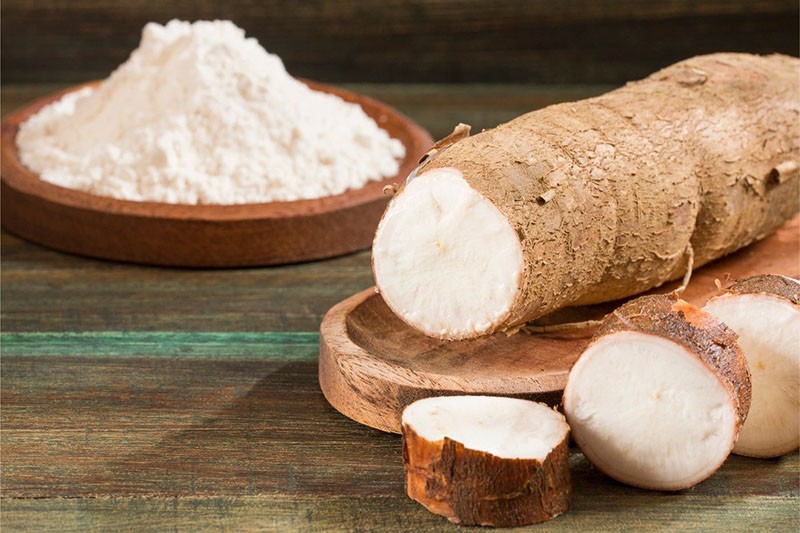Cassava - what is it and how to cook it correctly
 Cassava is an evergreen shrub introduced to Europe from the African tropics. Few people in Russia know about cassava - what it is, how to cook it correctly, and what harm an exotic plant can do to health. Meanwhile, cassava for many centuries remains one of the most popular and widespread crops in African countries, where it is used for culinary purposes and is highly valued for its pleasant, delicate taste.
Cassava is an evergreen shrub introduced to Europe from the African tropics. Few people in Russia know about cassava - what it is, how to cook it correctly, and what harm an exotic plant can do to health. Meanwhile, cassava for many centuries remains one of the most popular and widespread crops in African countries, where it is used for culinary purposes and is highly valued for its pleasant, delicate taste.
Cassava plant - what is it

Manioc - what is it and what features it has:
- The shrub height can reach 3-4 m in height. It has a beautiful decorative crown.
- The root system is large and powerful, the diameter of the roots can reach 10 cm, and the length is up to 1 m. Outwardly, it resembles rounded tubers.

- The central stem is large, dark green in color, woody with age.
- The crown of the plant consists of elongated, finger-dissected leaves, alternately located on a thick stem.
- During the flowering period, on the branches of cassava, inflorescences are formed in the form of a panicle or brush of a snow-white (yellow) color, and after its completion, fruits, small boxes containing seeds.
One of the features of cassava is the ability to quickly adapt to survival in the most difficult, extreme conditions.
Perennial grows well in hot, arid climates and can go for years without moisture. It is one of the most drought tolerant crops in the world. In Russia, the cassava plant is most often grown as an indoor or greenhouse crop.
Benefits of cassava root
 For culinary purposes, cassava root is used, the weight of which can reach 8-10 kg. The young roots of the plant are most often used for food, since their taste deteriorates as they grow older. The roots of a young shrub are suitable for culinary use one year after planting. But ripe roots acquire a rich taste only after 2 years.
For culinary purposes, cassava root is used, the weight of which can reach 8-10 kg. The young roots of the plant are most often used for food, since their taste deteriorates as they grow older. The roots of a young shrub are suitable for culinary use one year after planting. But ripe roots acquire a rich taste only after 2 years.
Edible manioc is famous not only for its excellent taste, reminiscent of young potatoes, but also for its beneficial properties.:
- Contains a high concentration of starch, due to which it improves the functioning of the digestive system and normalizes the intestinal microflora.
- Gently normalizes stools, helping to relieve constipation or diarrhea.
- Fights inflammatory processes in the body.
- Prevents the development of parasites in the body and accelerates the elimination of helminths in parasitic diseases.
- Stimulates blood circulation and increases hemoglobin.
- Contains a large amount of fiber, which naturally cleanses the body of toxins and toxic substances, activates metabolism.
- Strengthens the immune system.
- Improves the condition of skin, hair and nails.
Regular consumption of cassava helps to lower blood pressure, normalize blood cholesterol. This plant has a low glycemic index, so it can be used for diabetes.
Cassava in cooking
 Not all Russian gourmets know what cassava is and how to use it correctly. But it is one of the main herbal products in the national cuisine of Africa and South America.
Not all Russian gourmets know what cassava is and how to use it correctly. But it is one of the main herbal products in the national cuisine of Africa and South America.
Ways to eat cassava tubers:
- peeled tubers are boiled;
- the roots are baked;
- crushed to the state of flour.
Cassava tubers are used similarly to the usual potato root crops - they are served as a side dish with meat or fish, used as an ingredient vegetable casseroles and salads. Also, boiled roots are ground in mashed potatoes and used as the basis for various omelets, cereals and soups.
Cassava flour, obtained in the process of drying and grinding the roots of the plant, is used for baking and preparing cereals.
Also, chips, cookies and various confectionery products are prepared from cassava slices, pre-soaked and heat-treated.
 The ancient Indians used peeled and boiled cassava tubers to make kauim, kashiri and chicha. These are traditional alcoholic drinks of South America. They were finely chopped and poured with clean water, then left to ferment for several days.
The ancient Indians used peeled and boiled cassava tubers to make kauim, kashiri and chicha. These are traditional alcoholic drinks of South America. They were finely chopped and poured with clean water, then left to ferment for several days.
Cooking tapioca
 Most often, the tubers of a tropical plant are ground into powder - this is how a flour is obtained, which is also called tapioca. In fact, it is starch. It is one of the most popular foods used in a similar way to wheat flour - for making breads, tortillas and other baked goods.
Most often, the tubers of a tropical plant are ground into powder - this is how a flour is obtained, which is also called tapioca. In fact, it is starch. It is one of the most popular foods used in a similar way to wheat flour - for making breads, tortillas and other baked goods.
The process of its preparation is rather complicated and lengthy. For tapioca, the roots of the plant are washed and peeled from the dense rind. After that, the pulp is soaked in cool water for 2-3 days and rubbed thoroughly. After some time, grains of starch are released from the pounded mass, which begin to settle to the bottom of the container.
 Thereafter, the lower layer of starch particles is collected and re-filled with water. This procedure must be repeated at least 5 times. Then the resulting flour is sprinkled in a thin, even layer on metal baking sheets and dried well, stirring constantly. Under the influence of a small fire, small starchy particles combine into larger grains - this is tapioca.
Thereafter, the lower layer of starch particles is collected and re-filled with water. This procedure must be repeated at least 5 times. Then the resulting flour is sprinkled in a thin, even layer on metal baking sheets and dried well, stirring constantly. Under the influence of a small fire, small starchy particles combine into larger grains - this is tapioca.
Tapioca is the basis for the preparation of cassava sago - a cereal from which porridge and other dishes are prepared. This high-calorie and nutritious product is very popular in tropical countries.
Cassava harm
 Before using an exotic root, you need to consider not only what cassava is and how to cook it, but also what harm it can cause to the body. The main danger of cassava is the high concentration of hydrocyanic acid in its tubers. Its amount is so high that even 400-500 g of raw tuber can lead to severe poisoning or even death.
Before using an exotic root, you need to consider not only what cassava is and how to cook it, but also what harm it can cause to the body. The main danger of cassava is the high concentration of hydrocyanic acid in its tubers. Its amount is so high that even 400-500 g of raw tuber can lead to severe poisoning or even death.
That is why the roots of the plant are never eaten raw - this can lead to severe intoxication. They must undergo lengthy training. They are pre-soaked for 3-4 days in cool water. Then it is dried for 5-7 hours and heat treatment is carried out.
It is advisable to refuse the use of cassava for children, pregnant and lactating women. A tropical plant can cause allergies, as it is saturated with biologically active substances.
Cassava is a tropical plant, one of the most popular crops in Africa and South America. Cassava tubers are widely used in cooking. After all, they are known not only for their beneficial properties, but also for their pleasant taste, reminiscent of young potatoes. With proper preparation and preliminary preparation, cassava roots will help improve health and delight with excellent taste.